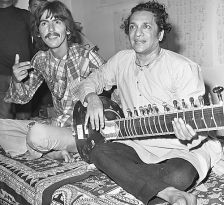 As Hugh Gregory (1999) stresses, in the 60s, American society turned its head to the East, to discover new ways of thinking, of understanding life and of living it. It was the perfect complement for the hippie movement: a thousand-year-old phylosophy with great ideas about physical and mental peace, as Ricardo Ribera (2003) reminds us. Thus, young hippies began to practice yoga, to convert into Hinduism and, of course, to listen to Hindi music. This last one, became more and more popular among youngsters, and singers, such as George Harrison, member of the Beatles, mentalized that different type of music. Music made by Ravi Shankar was the greatest influence of Oriental Music for the hippie music. Gregory (1999) states that now, a new music genre came on scene: the Psychedelic music, as the interest about oriental music was closely associated with the supposed spiritual “benefits” of the LSD, the drug on fashion at that time.
As Hugh Gregory (1999) stresses, in the 60s, American society turned its head to the East, to discover new ways of thinking, of understanding life and of living it. It was the perfect complement for the hippie movement: a thousand-year-old phylosophy with great ideas about physical and mental peace, as Ricardo Ribera (2003) reminds us. Thus, young hippies began to practice yoga, to convert into Hinduism and, of course, to listen to Hindi music. This last one, became more and more popular among youngsters, and singers, such as George Harrison, member of the Beatles, mentalized that different type of music. Music made by Ravi Shankar was the greatest influence of Oriental Music for the hippie music. Gregory (1999) states that now, a new music genre came on scene: the Psychedelic music, as the interest about oriental music was closely associated with the supposed spiritual “benefits” of the LSD, the drug on fashion at that time.
A great variety of Hindi musical instruments were introduced into 60s songs. There are many important instruments, but the most relevant ones are the tamboura, an instrument used to give a buzzing effect into the songs, and, probably the best known instrument of them all: the sitar which is a kind of guitar with a long fret, and was undoubtedly the most successful instrument among the 60s musicians who learned to play it correctly, having Ravi Shankar as their model to imitate. (Frith, 2007)
As it has already been said, many musical groups from the sixties were influenced by this musical trend, between them, the most notable ones were the Beatles, or several groups attached to the musical trend of psychedelic rock such as Jefferson Airplane and the Grateful Dead. (Frith, 2007)
The Beatles, probably the most influential band of this epoch, or even of the history of music, were really interested in Oriental Music. The group memeber most interested in it was the already mentioned George Harrison, who not only was interested about oriental music, but, thanks to the guru Maharasi Mahes Yogi, whom was visited by the Beatles in India, also became interested by the oriental spiritual practices. In 1965 Harrison had already bought a sitar and took lessons with the virtuous Ravi Shankar. And thanks to this renewed interest for Indian music, the songs of the Beatles turned into more psychedelic ones, as in those years, the interest about oriental music was closely associated with the supposed spiritual “benefits” that LSD, the drug on fashion at that time, carried with it. Here’s an example of a psychedelic Beatles song:
As you can see, this song is typically psychedelic, as it makes no sense at all. It doesn’t have a logical meaning. This is because, when applying the term “psychedelic”, you understood that with the use of drugs, especially the mentioned LSD, was present in the proccess of creation of the song. The other groups influenced by oriental music were the already mentioned Jefferson Airplane and the Grateful Dead, which are the most important psychedelic groups of history of music. Every musical instrument produced at India was included frequently by these groups, who defended the use of drugs. A clear example of a song by these groups is “White Rabbit”, which not only talks about drugs, but during the whole song you can hear a typical oriental sound (Miller, 1991):
Besides, and as a conclusion, it is important to mention that a great amount of musicians of the 60s were influenced by Indian music, and most of them can be attached to the psychedelic rock trend. Many examples of Indian instruments can be seen in songs by Jimi Hendrix or the Doors. So, not only the way of thinking, and the way of living the life changed, but also the way of understanding music was never the same anymore. (Issit, 2009).
- Inmaculada Ballano (2011). NOTES TAKEN FROM THE SECOND SEMESTER OF CULTURAL STUDIES.
- Hugh Gregory. Un siglo de pop. Editorial Blume, 1999. Barcelona.
- Ricardo Ribera. El año histórico de 1968. Diez acontecimientos que cambiaron el mundo. Departamento de filosofía de la Universidad Centroamericana. 2003. San Salvador. http://docs.google.com/
- Timothy Miller. The hippies and American values. 1991. The University of Tennessee Press, Knoxville. http://books.google.es/
- Micah L. Issit. Hippies. A guide to American subculture. 2009. Greenwood Press. Santa Barbara, California. http://books.google.es/
- Simon Frith. Taking music seriously: selected essays. 2007. Ashgate Publishing Limited. Hampshire, England. http://books.google.es/
Filed under: Anthropology, Arts, Humanities, Multiculturality Tagged: Beatles, George Harrison, Hinduism, India, Jimi Hendrix, Mizrahi music, Music of India, Ravi Shankar, Simon Frith, Timothy Miller
![]()


